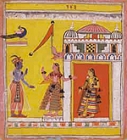東洋館 第3室
2009年1月14日(水) ~ 2009年4月5日(日)
インドにおける絵画の歴史は、紀元前から既に始まっていますが、細密画の最古の現存例は、棕櫚(しゅろ)の 葉に描かれた仏教やジャイナ教などの経典挿絵で11世紀頃にさかのぼります。当館のインド細密画は、ほとんどがムガル王朝時代(16~19世紀)に制作さ れたものです。その主題は、『マハーバーラタ』、『ラーマヤーナ』といったインド古来の神話、シヴァ神やヴィシュヌ神などのヒンドゥー教世界、諸々の王の 肖像や歴史的なエピソード、男女の恋の様相、動物の図などに加え、音楽を図像化したラーガ・マーラと呼ばれるインド独特の絵画もあり、インド世界では実に さまざまなテーマが絵画として表現されたことがわかります。
ムガル王朝時代の細密画は、イスラム文化圏で発達したムガル絵画と、ヒンドゥー文化圏のラージプト絵画に大別でき、また、地域によってムガル、地方ムガ ル、デカン、ラージャスターン、パハーリの5つに分類され、地域ごとに多様なスタイルがあります。バラエティに富んだ主題とスタイルを持った1枚ずつの絵 を通して、貴族の生活の豊かさや当時の人々の信仰のあり方などをうかがうことができるでしょう。
ムガル王朝時代の細密画は、イスラム文化圏で発達したムガル絵画と、ヒンドゥー文化圏のラージプト絵画に大別でき、また、地域によってムガル、地方ムガ ル、デカン、ラージャスターン、パハーリの5つに分類され、地域ごとに多様なスタイルがあります。バラエティに富んだ主題とスタイルを持った1枚ずつの絵 を通して、貴族の生活の豊かさや当時の人々の信仰のあり方などをうかがうことができるでしょう。
前期:2009年1月14日(水)~2009年2月22日(日)
後期:2009年2月24日(火)~2009年4月5日(日)

